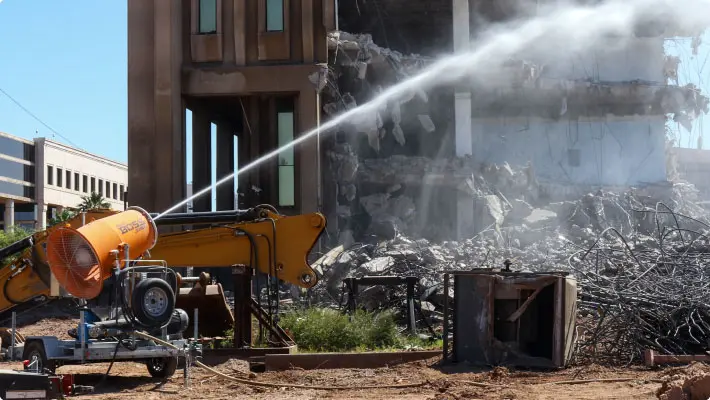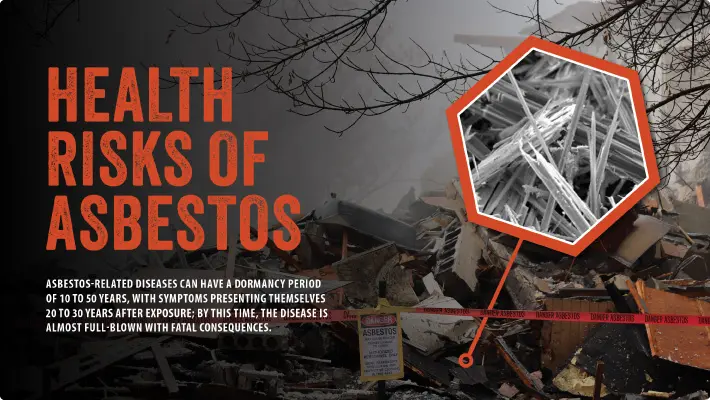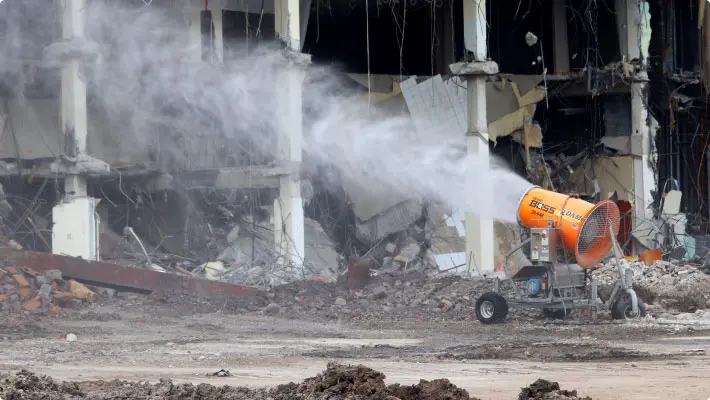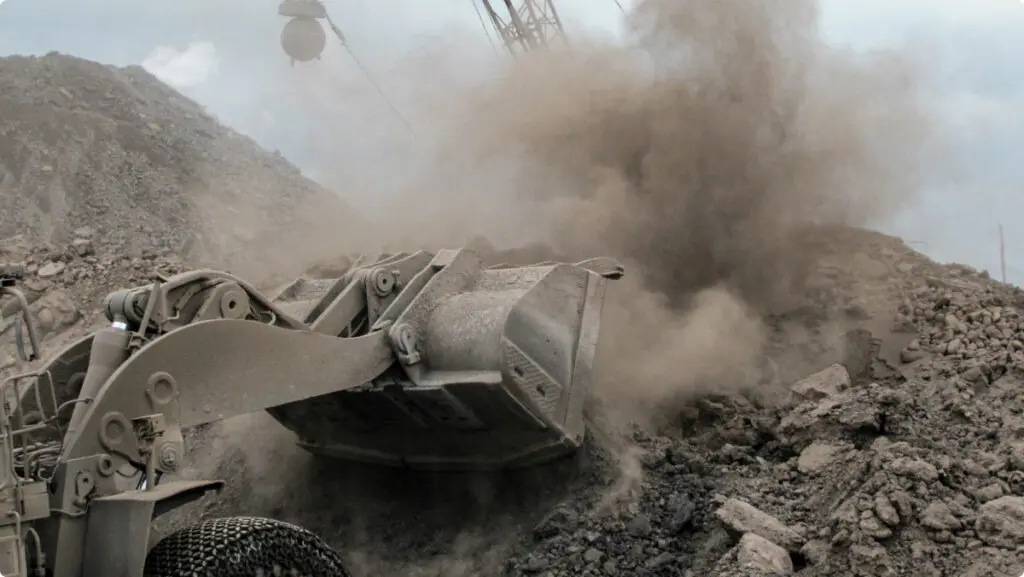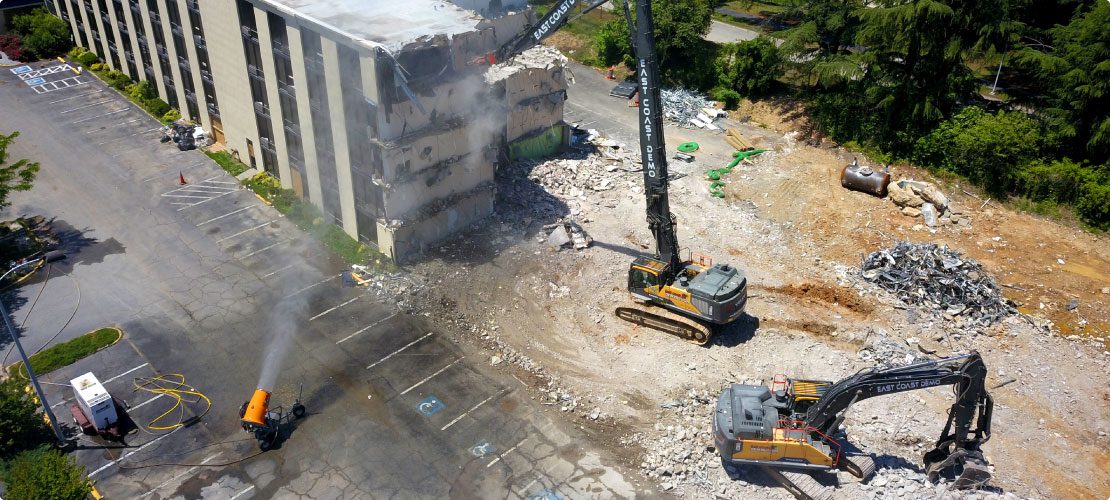
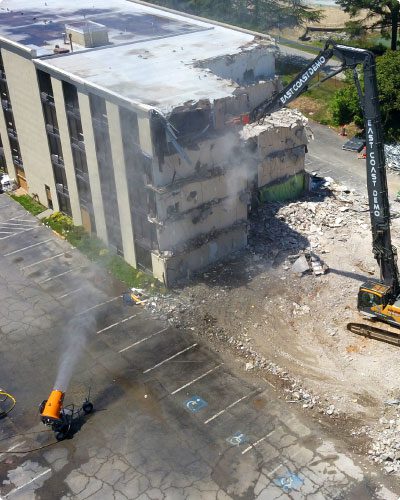
Demolition contractors struggle with the question: when is it more cost-effective to rent dust control equipment rather than own it?
The answer is a moving target, calculated according to the needs and finances of each individual company.
In Europe, contractors use rental equipment heavily, more than 70 percent of the time by some estimates. Their theory is to get the job, rent the specific equipment needed to get it done efficiently and then return the equipment when finished.
No maintenance, no repairs. As a result, the contractors know the exact costs for equipment utilization for each project and for similar projects in the future.
It’s estimated that U.S. contractors rent equipment for about 40 percent of their projects, but that figure has been trending steadily upward. This is especially true in times when jobs are harder to come by and tend to be smaller in scope, and when equipment needs can be more specialized.
Capital equipment budgets are often strained during these periods, and financing can be difficult to obtain. For most contractors, there just isn’t enough steady work to justify ownership unless the utilization rate is somewhere around 65 percent or higher. Otherwise, that equipment is costing money.
Any contractor not currently using a plan to track daily equipment activity should start doing so immediately. While it’s beneficial to project those costs for the coming months, the more valuable data would be to chart the utilization over the past 12 months.
If a contractor charges projects for the costs of owning and operating equipment -- and consistently recovers them -- ownership can make financial sense. But if the expenses of owning, operating, and maintaining those units approach the level of income derived, then it may be time to rethink strategy.

BENEFITS OF DUST CONTROL RENTALS
Capital expenditures for equipment are seen as a major financial risk during periods of uncertain growth. When the market crashed, many contractors had to auction off equipment. Some had to raise capital. Others had older equipment that didn’t meet current regulations or cost more than they produced.
But as markets begin to build up again, contractors are looking for ways to access additional equipment to bid new jobs or find specialized equipment that will position them for entering new markets.
For years, the only way a contractor could obtain dust suppression equipment was to buy it. But the advantages of renting can include maintaining cash reserves, controlling budgets, containing costs, and adding flexibility. Renting also allows contractors to test equipment under actual job site conditions before investing in a specific brand or model.
When contractors buy their own equipment, they’re either paying finance charges or tying up capital that might otherwise go toward core business activities.
As equipment costs and finance charges rise, renting can be a more attractive alternative. It may also provide tax benefits.
Investing cash for capital equipment can hamper a company’s growth potential and limit the flexibility needed to meet cash flow demands during slow business cycles. Companies with sufficient cash reserves can better withstand economic downturns.
See dust control equipment suppressing fugitive dust particles in various demolitions!
Renting typically requires only a deposit and first-period payment, while even financed purchases often require a large down payment.
With access to capital a challenge, renting can free up resources for other needs. In some cases, it may be the only practical option and it can help manage capital risks.
Renting can allow contractors to bid on jobs outside of their normal service area, with dust suppression equipment delivered directly to the job site. Rented equipment can also help meet short-term equipment needs.
In some demolitions, for example, dust management is a strict requirement, subject to verification. Renting can help contractors quickly gear up for those jobs, without the lead times that often accompany a new equipment purchase.
Further, rental payments are fixed and predictable. What contractors really buy when they rent is uptime, performance, and reliability. Most equipment is of recent vintage and rented equipment tends to have low hours.
When combined with the OEM’s maintenance schedules and trained technicians, rentals can help contractors avoid breakdowns that require transportation, shop time, and/or downtime. The result is stable, managed cost and improved ability to keep projects on track.

TRUE COST OF OWNING DUST CONTROL EQUIPMENT
The most apparent operating costs of owned equipment include energy, routine maintenance, repairs, parts, depreciation, insurance, and administrative expenses. All of these ongoing costs must be factored into a life cycle analysis, compounding the true life cycle cost of that equipment far beyond the purchase price.
Maintenance and repair costs in particular are key factors in any buy/rent decision. Equipment owners must either have the expertise on staff to handle upkeep and repairs, or pay a service contractor for parts and labor. And when any units are down for repair, job progress can suffer.
With a rental unit, those obligations are borne by the renting company. Any breakdowns that do occur can typically be addressed with repair parts or a replacement machine. Many suppliers will also provide instruction on making small repairs. In addition, equipment rental eliminates almost all of the contractor’s storage responsibility, passing along just a fraction of those costs to the renter as part of the rental rate. Because the costs are shared by a number of renters, they are more affordable for all.
While equipment ownership costs rise over a machine’s lifespan and add to overall operating costs, rental equipment has a known, predetermined rate over the life of the contract. With maintenance and repair costs built in and shared, the contractor’s risk is greatly reduced. There are no nasty equipment surprises, as breakdowns are someone else’s responsibility.
Storage and transportation are another issue. Owned equipment, even when stored outdoors, requires a secure location when not in use. The ability to haul equipment to job sites also requires vehicles, trailers, fuel and insurance, while most rental operations will either deliver the equipment and pick it up or arrange for shipping to and from the job site.
READY FOR A QUOTE?
Talk to a dust control specialist and get a quick quote for your project.
THE RIGHT MODEL FOR EVERY DEMOLITION DUST CONTROL JOB
Equipment owners can also suffer from a lack of versatility. Small projects may require just one or two modest-sized dust control units, for example, while larger jobs may call for multiple units of the largest size available. Renting delivers the flexibility to obtain the most appropriate equipment for every project, regardless of its scope.
This can take a load off contractors when their equipment needs change, or when it’s difficult to predict exactly which equipment will be needed before a project gets underway.
Renting allows contractors to adjust their equipment mix as needs evolve. Some dust control units will provide thousands of hours of trouble-free service, while others may require frequent attention. In either case, even well-maintained equipment will depreciate over time.
Renting eliminates depreciation schedules, since lease payments are generally line items on a company’s profit and loss statement. By not having equipment debt on the balance sheet, a company can be a more attractive customer to lending institutions for other financial needs.
There’s also an obsolescence factor: equipment owners may find that over time, significant advancements are made that can improve the utility or efficiency of newer machines. With rental equipment, there’s little chance that units will become obsolete before they wear out.
In recent years, new advancements in dust suppression technology have brought previously unavailable performance to contractors, including greater oscillation ranges, expanded coverage and other innovations. Renters have the ability to take advantage of these by renting the most current models, without having to retrofit their own existing equipment.
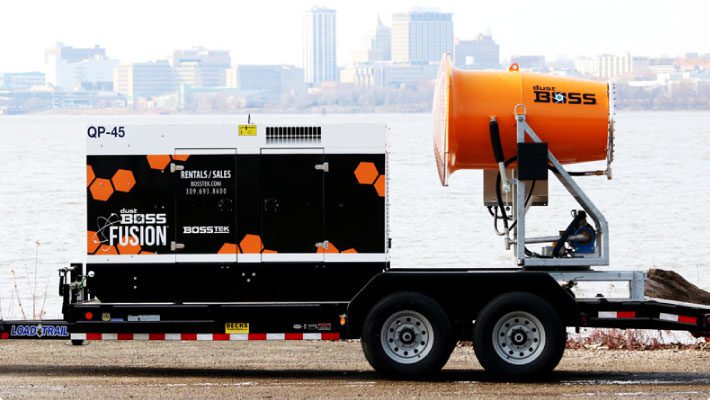
Self-powered DustBoss dust control system.
Compliance and safety can be another issue. Equipment owners bear the responsibility of keeping their machines in good working order, with all safety components in place and operating.
In most situations, when contractors rent, the expenses of inspections and safety upgrades are handled by the rental company. In the case of “self-contained” dust control equipment, that can include maintenance and repair of diesel engines, generators, water tanks and other components. As EPA, OSHA and other agency regulations continue to tighten, the cost of the required record-keeping can actually be higher than keeping the equipment up to date. With a rental, the contractor doesn’t have to worry about it, relying instead on the rental house to handle the updates and paperwork.
TRENDS IN RENTING
In the current business climate, national rental companies are seeing double-digit growth, even without similar growth in the end markets they serve. Contractors are becoming more aware of rental options, and are using them more than in previous economic cycles. This is one of the strongest periods of rental sampling ever, in part because more companies are challenged with buying.
Some rental companies offer a rent-to-own option, allowing contractors to sample different types and sizes of equipment, delaying a purchase until they attain a degree of certainty over which model(s) are most appropriate for their business. Once reaching a firm decision, a portion of the rental is applied to the purchase price.
More than ever before, contractors are becoming hypersensitive to downtime. The maintenance schedules for rental equipment should keep machines running at high efficiency and reliability, and repairs are not the responsibility of the renter.
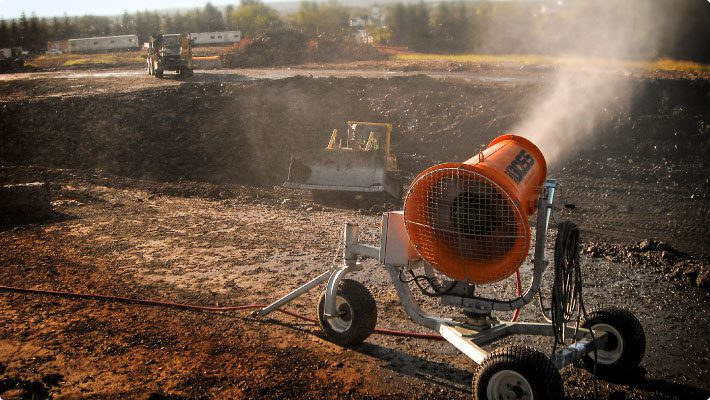
CONCLUSIONS
Unless a company has secure, fixed-term contracts, future equipment utilization is at best an educated guess. By some estimates, equipment used more than 60-65 percent of the time is probably more economical to own than rent. Less than 60 percent utilization can be a financial risk, unless there is sufficient volume and profit margins to cover all costs and maintenance. Anything less than 40 percent utilization and it’s almost always more cost-effective to rent.
Many companies are now balancing their core fleet with rental equipment that might be needed for specialized projects or for a short duration. Companies with a growing number of projects may use rental dust control equipment to capture new business, while protecting available working capital. Predicted usage, the measurement that ultimately justifies equipment acquisitions, is usually based on an analysis of current projects and jobs in the pipeline.
But funding cuts and delays resulting from the recession are keeping those pipeline flows weak and what funding is available is often directed to shorter-duration and less expensive projects. This transition to projects of shorter duration aggravates the situation for contractors.
Instead of planning lengthy projects, contractors are trying to schedule a larger number of shorter jobs, with the inherent risk of downtime in between. Renting allows contractors to add equipment on an as-needed, piece-by-piece basis for each project.
Originally published March 7, 2014. Updated as of October 2019.
GET A QUOTE AND TAKE DOWN DUST WITH DUSTBOSS!
Receive a quote and talk to a dust control specialist today to end fugitive dust!
